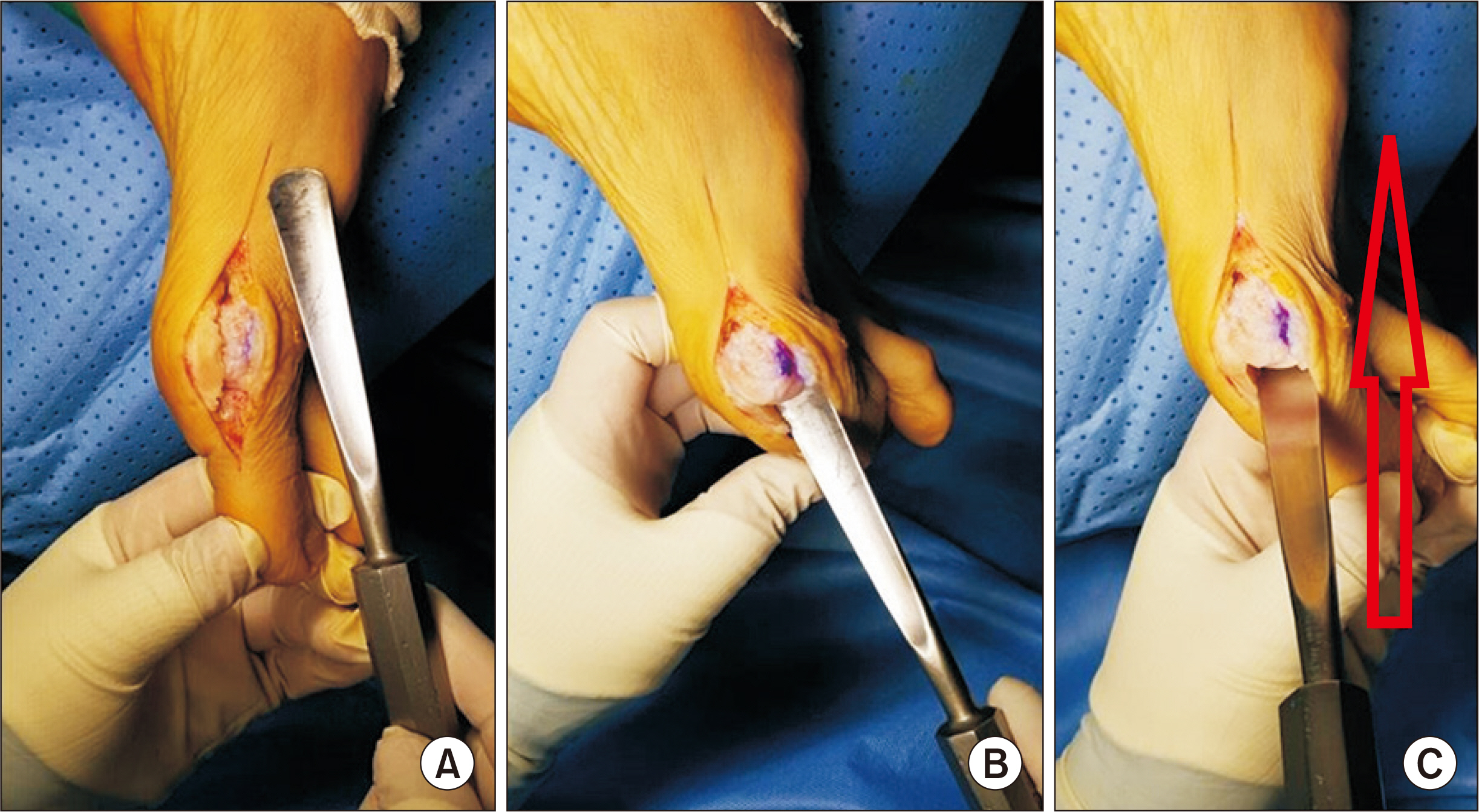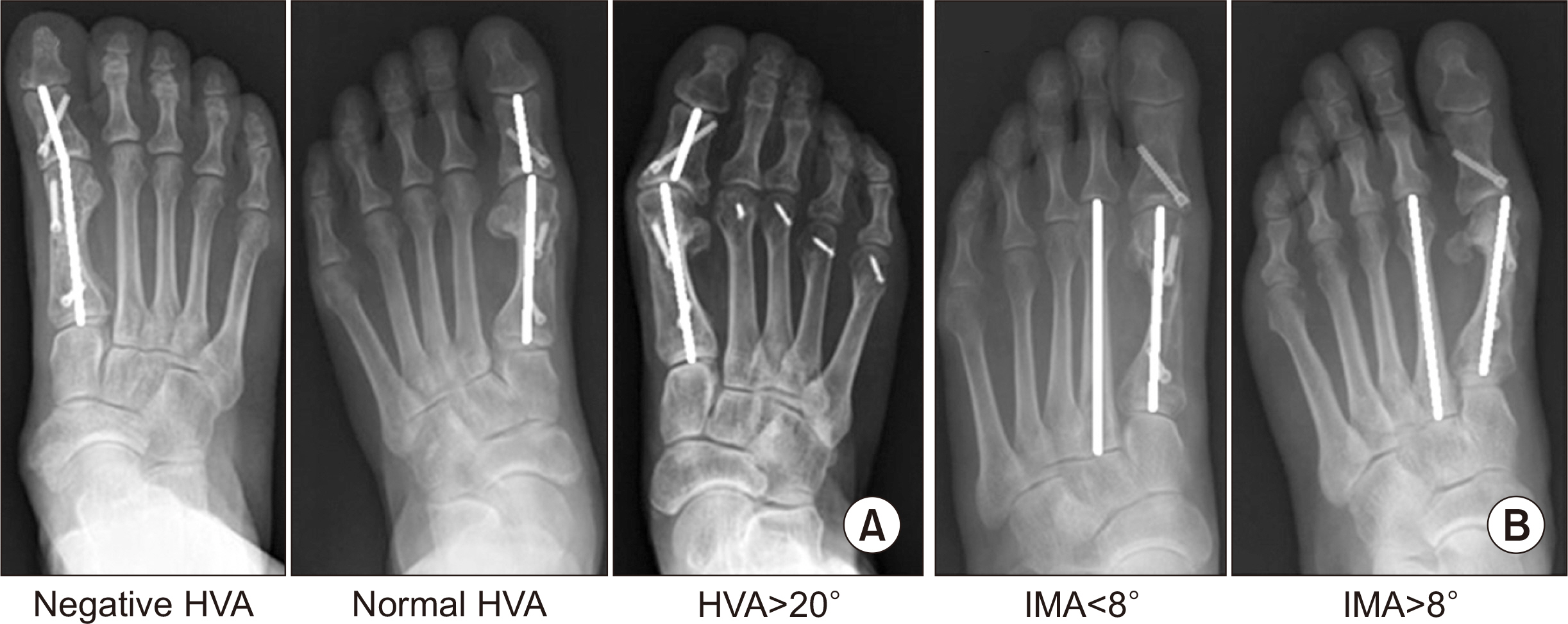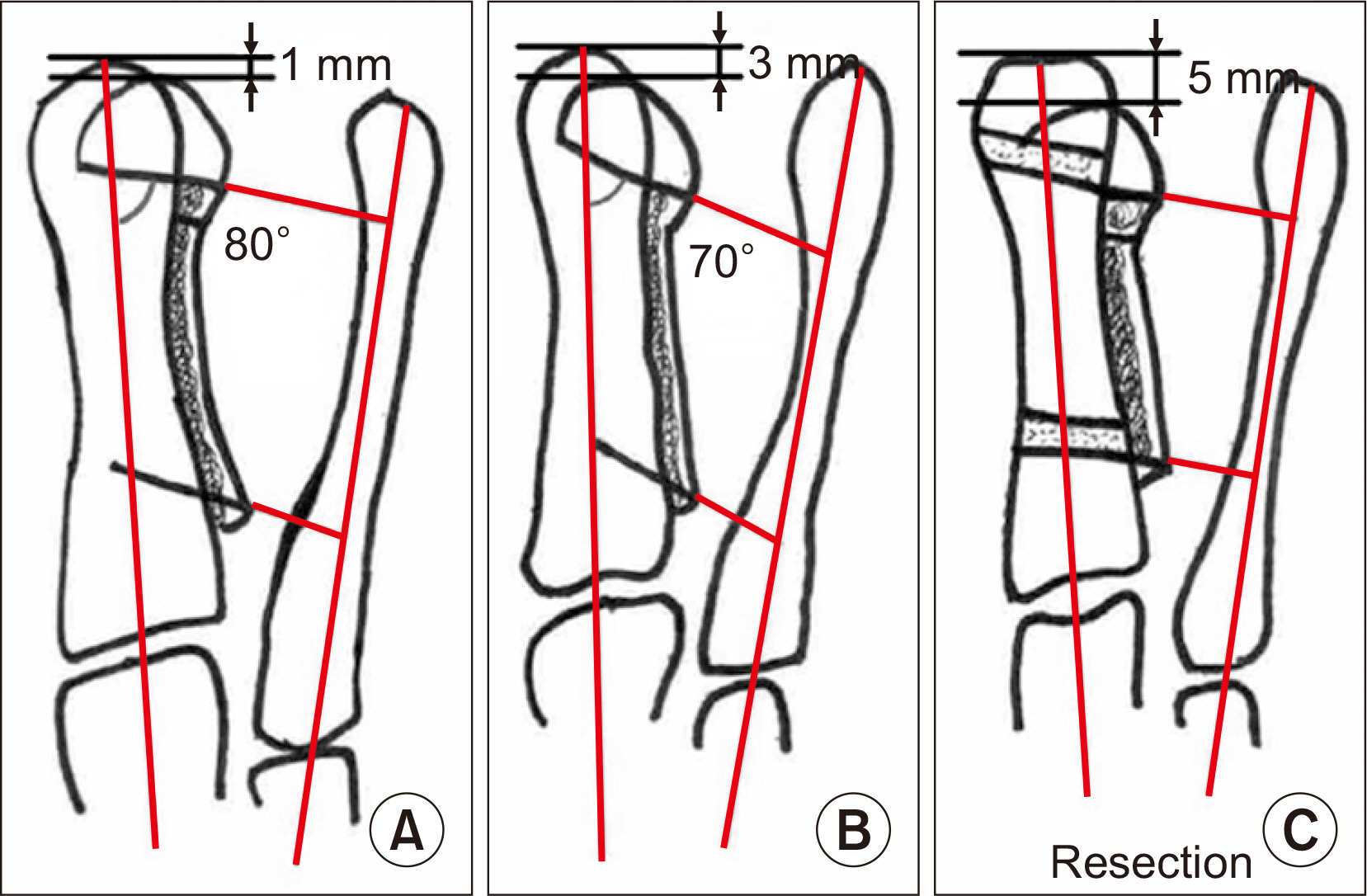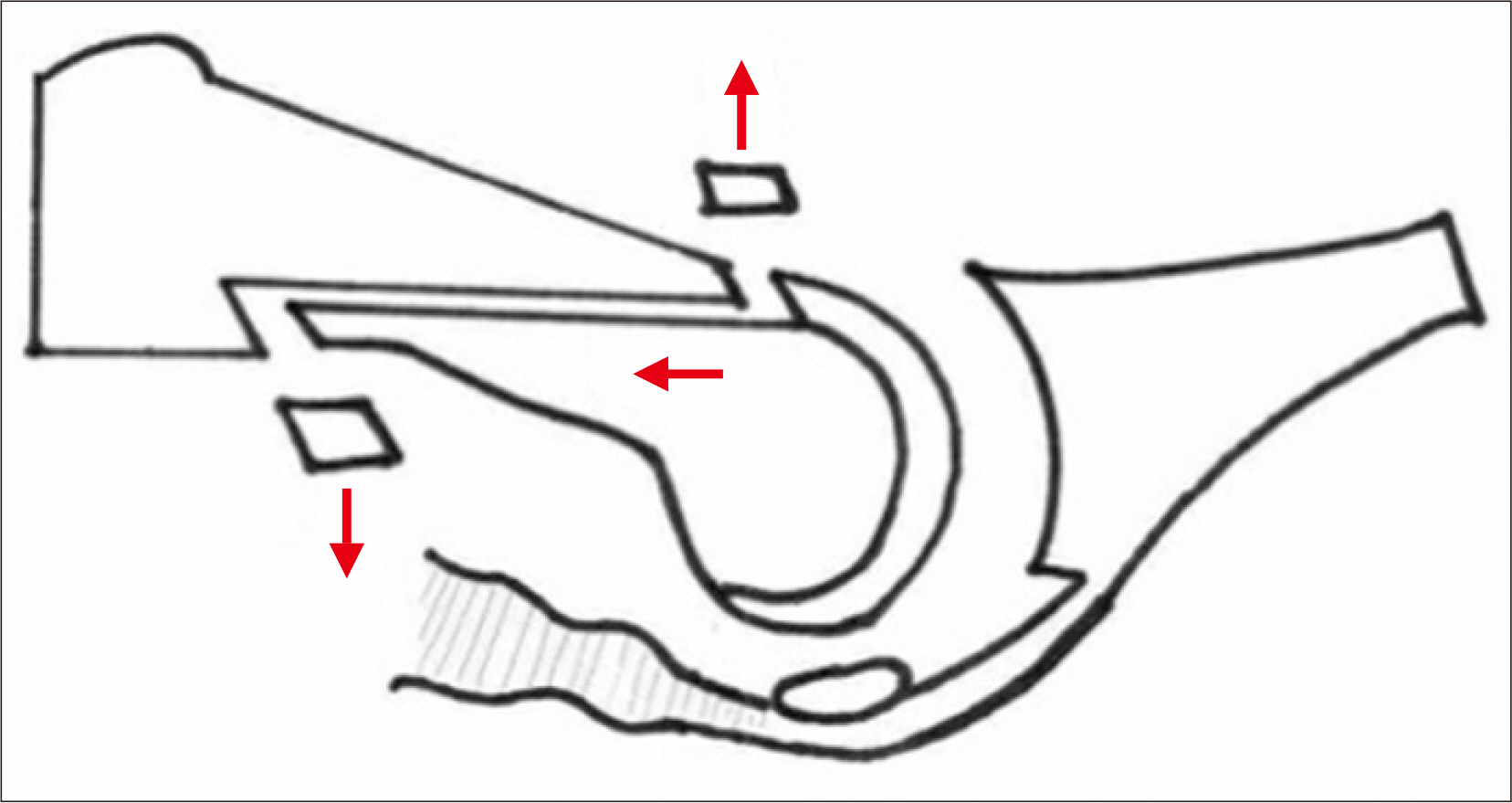J Korean Foot Ankle Soc.
2020 Dec;24(4):135-141. 10.14193/jkfas.2020.24.4.135.
Comparative Analysis of the Results between the Early Period and the Midterm Period of a Single Surgeon’s Experience in the Treatment of Hallux Valgus Using Scarf Osteotomy
- Affiliations
-
- 1Department of Orthopedic Surgery, Pohang St. Mary’s Hospital, Pohang, Korea
- KMID: 2509534
- DOI: http://doi.org/10.14193/jkfas.2020.24.4.135
Abstract
- Purpose
This study evaluated the results of two groups—the early group and midterm group—comparatively in the treatment of hallux valgus using a scarf osteotomy.
Materials and Methods
From January 2005 to December 2009 (Group 1) and from January 2010 to December 2013 (Group 2), this study compared hallux valgus cases treated by a scarf osteotomy by a single surgeon with at least a five-year follow-up.
Results
The average ages of Group 1 and Group 2 were 50.5 and 51.7 years old, respectively. The average follow-up of Groups 1 and 2 were 7.4 and 6.2 years, respectively. Groups 1 and 2 had 86 cases (53 patients) and 93 cases (64 patients) with at least a five-year followup, respectively. The average hallux valgus angle (HVA) and 1-2 intermetatarsal angle (IMA) of Group 1 were improved from 31.3° and 13.9° preoperatively to 11.3° and 6.8° at the final follow-up, respectively (p<0.001). The average HVA and 1-2 IMA of Group 2 were improved from 31.7° and 13.4° preoperatively to 8.9° and 6.6° at the final follow-up, respectively (p<0.001). The mean American Orthopaedic Foot and Ankle Society (AOFAS) score of both groups increased from 48.5 and 45.0 points preoperatively to 73.7 and 82.4 points at the final follow-up, respectively. The numbers of patient-assessed subjective satisfaction of Groups 1 and 2 at the final follow-ups were as follows: excellent, 27 and 36 (31.4%, 38.7%); good, 34 and 49 (39.5%, 52.7%); fair, 13 and 5 (15.1%, 5.4%); poor, 12 and 3 (13.9%, 3.2%); respectively. Neither troughing nor stress fractures occurred in both groups.
Conclusion
Scarf osteotomy for treating hallux valgus is an excellent surgical method with a relatively low incidence of complications. The results in Group 2 were better than those in Group 1, showing that more surgical experience and evolution of the techniques provided better results.
Figure
Reference
-
1. Barouk LS. 1995; Scarf osteotomy of the first metatarsal in the treatment of hallux valgus. Foot Diseases. 2:35–48.2. Barouk LS. 2000; Scarf osteotomy for hallux valgus correction. Local anatomy, surgical technique, and combination with other forefoot procedures. Foot Ankle Clin. 5:525–58.3. Barouk LS. 2005. Forefoot reconstruction. 2nd ed. Springer-Verlag France, Paris;Paris: p. 25–77. p. 94–105. p. 179–204. DOI: 10.1007/2-287-28937-2_8.4. Nam IH, Ahn GY, Moon GH, Lee YH, Choi SP, Lee TH. 2014; Complications of scarf osteotomy for hallux valgus. J Korean Foot Ankle Soc. 18:178–82. doi: 10.14193/jkfas.2014.18.4.178. DOI: 10.14193/jkfas.2014.18.4.178.
Article5. Smith AM, Alwan T, Davies MS. 2003; Perioperative complications of the Scarf osteotomy. Foot Ankle Int. 24:222–7. doi: 10.1177/107110070302400304. DOI: 10.1177/107110070302400304. PMID: 12793484.
Article6. Larholt J, Kilmartin TE. 2010; Rotational scarf and akin osteotomy for correction of hallux valgus associated with metatarsus adductus. Foot Ankle Int. 31:220–8. doi: 10.3113/FAI.2010.0220. DOI: 10.3113/FAI.2010.0220. PMID: 20230700.
Article7. Murawski CD, Egan CJ, Kennedy JG. 2011; A rotational scarf osteotomy decreases troughing when treating hallux valgus. Clin Orthop Relat Res. 469:847–53. doi: 10.1007/s11999-010-1647-3. DOI: 10.1007/s11999-010-1647-3. PMID: 20976578. PMCID: PMC3032838.
Article8. Trnka HJ, Parks BG, Ivanic G, Chu IT, Easley ME, Schon LC, et al. 2000; Six first metatarsal shaft osteotomies: mechanical and immobilization comparisons. Clin Orthop Relat Res. (381):256–65. doi: 10.1097/00003086-200012000-00030. DOI: 10.1097/00003086-200012000-00030. PMID: 11127663.9. Coetzee JC. 2003; Scarf osteotomy for hallux valgus repair: the dark side. Foot Ankle Int. 24:29–33. doi: 10.1177/107110070302400104. DOI: 10.1177/107110070302400104. PMID: 12540078.
Article10. Valentin B, Leemrijse Th. Scarf osteotomy of the first metatarsal: a review of the first 56 cases (5 years follow-up) and improvement of the surgical techniques. In : AFCP 2nd International Spring Meeting; 2000 May 4-6; Bordeaux, France.11. Kristen KH, Berger C, Stelzig S, Thalhammer E, Posch M, Engel A. 2002; The SCARF osteotomy for the correction of hallux valgus deformities. Foot Ankle Int. 23:221–9. doi: 10.1177/107110070202300306. DOI: 10.1177/107110070202300306. PMID: 11934064.
Article12. Dereymaeker G. 2000; Scarf osteotomy for correction of hallux valgus. Foot Ankle Clin. 5:513–24.13. Rippstein P, Zünd T. 2001; [The "scarf" osteotomy for the correction of hallux valgus]. Oper Orthop Traumatol. 13:107–20. German doi: 10.1007/PL00002275. DOI: 10.1007/PL00002275.14. Coetzee JC, Rippstein P. 2007; Surgical strategies: scarf osteotomy for hallux valgus. Foot Ankle Int. 28:529–35. doi: 10.3113/FAI.2007.0529. DOI: 10.3113/FAI.2007.0529. PMID: 17475155.
Article
- Full Text Links
- Actions
-
Cited
- CITED
-
- Close
- Share
- Similar articles
-
- Treatment Results of Hallux Valgus Deformity by Parallel-Shaped Modified Scarf Osteotomy
- Multi-dimentional Correction of the Scarf Osteotomy for the Treatment of Hallux Valgus
- Scarf Osteotomy for the Treatment of Recurred Hallux Valgus
- Modified Proximal Scarf Osteotomy for Hallux Valgus
- Short Scarf Osteotomy for Moderate Hallux Valgus








